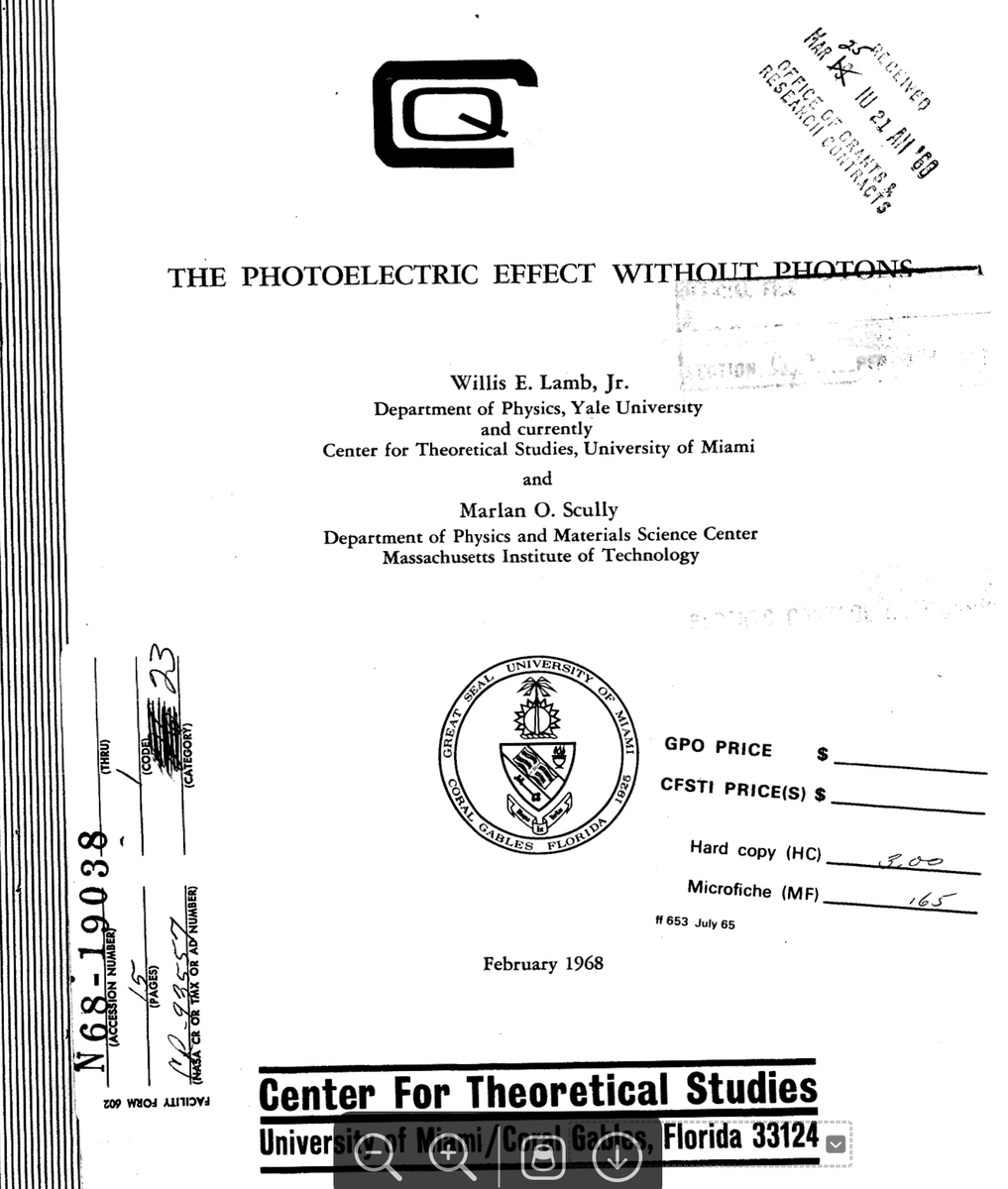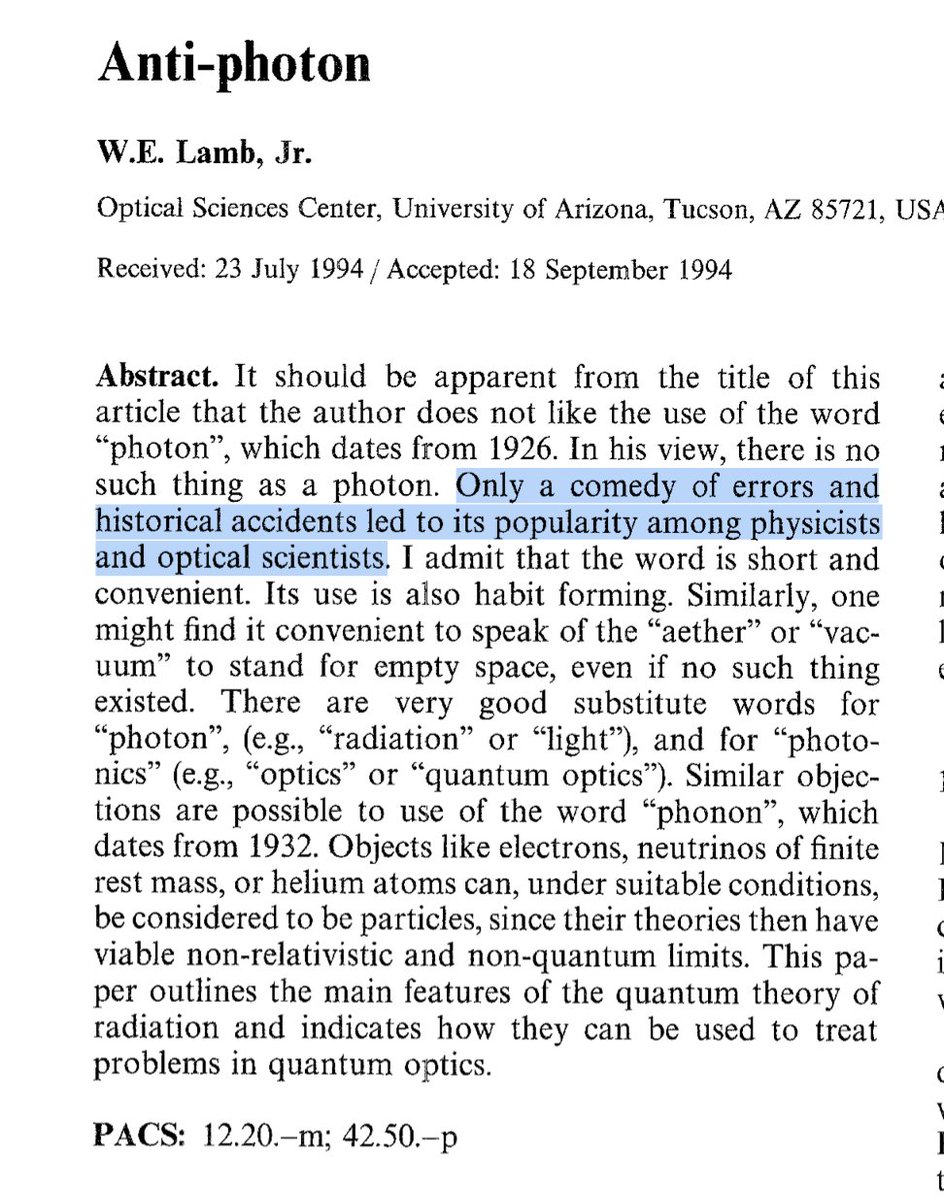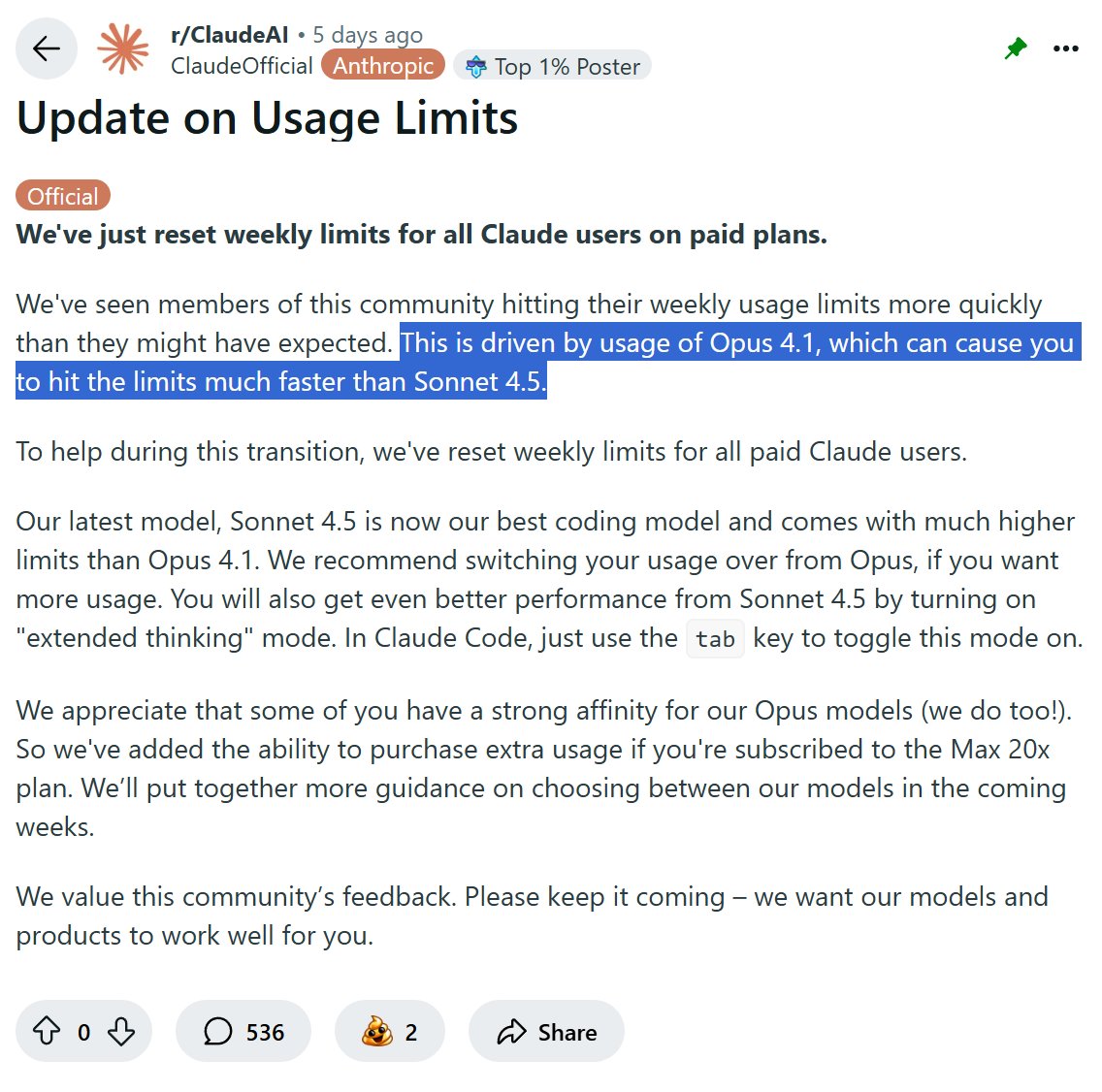What do nuclear weapons SOUND like?
The short answer is a gunshot (akin to a shotgun), followed by a turbulent roar. Here is a rare, captured example from the Upshot-Knothole Annie test, 1953.
This thread will explain why nukes sounds like gunshots & why regular bombs don't!
/🧵
The short answer is a gunshot (akin to a shotgun), followed by a turbulent roar. Here is a rare, captured example from the Upshot-Knothole Annie test, 1953.
This thread will explain why nukes sounds like gunshots & why regular bombs don't!
/🧵
Just in case there is any doubt, the media agrees:
In an article posted by the Atlantic "The Sound of an Atomic Bomb", the audio is described in this manner:
"The boom is more like a shotgun than a thunderclap, and it’s followed by a sustained roar."
theatlantic.com/technology/arc…

In an article posted by the Atlantic "The Sound of an Atomic Bomb", the audio is described in this manner:
"The boom is more like a shotgun than a thunderclap, and it’s followed by a sustained roar."
theatlantic.com/technology/arc…

We are lucky to have this footage, thanks to fears of nuclear bombs at the time which resulted in civilian reporters taking this very rare video.
Actually no one was really interested in the sound of a nuke -- scientists considered the question obvious!
blog.nuclearsecrecy.com/2012/07/13/the…
Actually no one was really interested in the sound of a nuke -- scientists considered the question obvious!
blog.nuclearsecrecy.com/2012/07/13/the…
Yet, to this day we get audio like this: A screaming lady sound followed by what sounds like the most noisy and loud jet sound ever.
The notion of this is absurd if you understand how nukes work!
More importantly, this false ideal can obstruct classification of explosions!
The notion of this is absurd if you understand how nukes work!
More importantly, this false ideal can obstruct classification of explosions!
Detection of nuclear explosions is actually not as straight-forward as its made out to be, an analyst must make a human decision based on multiple sources of data.
Acoustic detection of nuclear explosion is one such method employed, using "infrasound" detectors.
Let's explore:


Acoustic detection of nuclear explosion is one such method employed, using "infrasound" detectors.
Let's explore:


Infrasounds are sounds with frequencies below our range of hearing 20 Hertz or below. Why do nuclear detectors aim to measure this range?
Well, they have to cover a long distance and sound at higher frequencies is absorbed more readily by air than that at lower frequencies.
Well, they have to cover a long distance and sound at higher frequencies is absorbed more readily by air than that at lower frequencies.

For those with some technical background, we can roughly say that air acts similarly to a single pole low-pass filter at moderate levels of humidity. That is to say, higher frequencies are rapidly muted: e.g. a 8000Hz sound is absorbed 100x more over a distance than 100Hz.
The longer the distance travelled by a sound, the more energy within the wave is absorbed by the air!
When a component of sound is absorbed to the point where it is below your dynamic threshold of hearing (i.e. above the noise level of what is around you), it becomes inaudible.
When a component of sound is absorbed to the point where it is below your dynamic threshold of hearing (i.e. above the noise level of what is around you), it becomes inaudible.
If you've ever been near a house party, where the sound gets absorbed by walls (which emulates long travel through the air). you can immediately relate to this effect.
You can only hear the thumping bass and not the rich treble making the experience annoying if you're a neighbor.
You can only hear the thumping bass and not the rich treble making the experience annoying if you're a neighbor.
Let's move back to detonation of nukes now, focusing on air burst.
I described the operation of nuclear bombs extensively in this thread:
I described the operation of nuclear bombs extensively in this thread:
https://x.com/cirnosad/status/1661129221933264897
Modelling the sound a nuclear bomb emits is not an easy task. But we can use some tricks.
This video was shot during the Trinity test, which captures the moment the physics package overcomes the pressure of the explosive lens and the casing of the nuclear bomb. Note the symmetry.
This video was shot during the Trinity test, which captures the moment the physics package overcomes the pressure of the explosive lens and the casing of the nuclear bomb. Note the symmetry.
The video was shot at a rate of around 10 nanoseconds per shot. When the fireball forms, it can be modelled by a sphere.
This is an extremely convenient shape -- but we must note that internally it has a great deal of turbulence.
The strange "spikes" are caused by irregularities.
This is an extremely convenient shape -- but we must note that internally it has a great deal of turbulence.
The strange "spikes" are caused by irregularities.

The initial plasma, formed by xray absorption in the air/casing, is extremely hot, 100 million Kelvin -- 4-5 times hotter than the atmosphere of the sun. The air around it is immediately turned into a plasma as well, expanding VERY rapidly.
This displaces a greater sphere of air.
This displaces a greater sphere of air.

This displacement happens extremely quickly. Imagine a rock in a puddle and observing the wave. This is kind of what happens when you create a plasma ball -- the air pressure pushes it in and keeps it from escaping to space, but it also pushes on the air creating the wave.
In fact, for an atmospheric explosion, 50-60% of the energy goes into formation of this blast or shockwave. It is in fact a sound wave!
That's right, air burst mode nuclear weapon's primary destructive power is sound, unlike conventional bombs which use fragmentation.
That's right, air burst mode nuclear weapon's primary destructive power is sound, unlike conventional bombs which use fragmentation.

So all that energy goes into creating a "pulse". If we use radial coordinates, due to the spherical symmetry we model this nuke at, this "pulse" is generated exactly around the shape of the initial plasma ball prior to expansion, which moves meters over the course of nanoseconds.
Let's look at a modern nuclear bomb, most likely to be used against Russia in the coming months: The W80-Mod4.
You can see how small this thing is, less than 50 centimeters. In a matter of nanoseconds, this will expand to 250 meters or more depending on the yield.
You can see how small this thing is, less than 50 centimeters. In a matter of nanoseconds, this will expand to 250 meters or more depending on the yield.

Given the spherical symmetry, we can cheat a little bit, we can go into negative time and create a shockwave that is compressed with all the energy in what is called a Dirac Delta. In the frequency spectrum, this simply means all audible frequencies have the same frequency! 

How does this pulse move? Well, forwards and at the speed of sound in both directions of course, but let's make life simple and only consider the incoming direction.
How are the frequencies adjusted? Well, we already know: the higher frequencies lose the most energy.
How are the frequencies adjusted? Well, we already know: the higher frequencies lose the most energy.
But as this energy is so immense (50% of the power of the bomb) and as this pulse is so tight that it forms a shockwave, the sound remains a pulse, with most of the components of the audible frequencies still above the noise level. Well you would hope, too close and you're dead!
This is of course in the ideal scenario! In most cases, there will be variations in the atmosphere and also along the ground (such as hills, buildings and so on) that create a complex path that is difficult to analyse without a simulation: But this pulse remains a key signature.
What does a small and short pulse that contains a lot of energy, followed by some turbulence due to irregularities and non-linearity sound like?
A shotgun. In fact, by using Schlieren photography we can visual the convolved Dirac delta pulse AND the turbulence in this case:


A shotgun. In fact, by using Schlieren photography we can visual the convolved Dirac delta pulse AND the turbulence in this case:


Let's investigate a suspected nuclear blast.
This one is from Southern Lebanon, carried out by an Israeli jet. We can hear the jet prior to the sound, which is a gunshot followed by some turbulence.
We can even see the shockwave, which reaches high into the sky then the camera.
This one is from Southern Lebanon, carried out by an Israeli jet. We can hear the jet prior to the sound, which is a gunshot followed by some turbulence.
We can even see the shockwave, which reaches high into the sky then the camera.
Putting this video into a professional audio editor we can see how SHARP this shockwave is, and how it fills all the frequencies that the camera mic can capture, dropping off sharply at its max input frequency of 15kHz.
But herein lies an important detail! Look at the slope!
But herein lies an important detail! Look at the slope!

Close examination shows a 34dB drop in power. This is approximately similar to the air propagation constant we detected earlier, considering a propagation of 1.9km by sound delay.
Inverting this, we can reconstruct the source: Fairly flat across frequencies! A Dirac Delta! ☢️🚨


Inverting this, we can reconstruct the source: Fairly flat across frequencies! A Dirac Delta! ☢️🚨


Note that, of course, sounds other than a nuke can produce a Dirac delta, but when we consider the intense and sustained light, as well as other evidence such as the Rayleigh-Taylor instability observed, and the lack of anything else that could possibly cause this, it is a nuke.
Next up, let's take a look at a conventional explosion and why it doesn't sound the same as a gunshot, and more like a drum.
I wrote all about conventional bombs in this thread, which would make a useful reference for all readers:
I wrote all about conventional bombs in this thread, which would make a useful reference for all readers:
https://x.com/cirnosad/status/1659806111296536576
A well designed bomb usually has symmetrical or central primers, so that the detonation wave inside the bomb occurs from both ends and is symmetrical as possible. This creates a deadly shockwave and a complete detonation which sends destructive fragments flying into the air. 

Nevertheless, no matter how symmetric the conventional bomb is, this speed of detonation is actually quite slow, to the point where the bomb, when it hits the ground, spreads outwards rather than vertically. It also has far less energy than a nuke.
So what you have is still a somewhat oblong shockwave, moving at the same speed, but after 2 kilometres of propagation, the energy contained in the higher frequencies will be below the threshold of detection and hearing.
This makes it exactly like the party in another room!
This makes it exactly like the party in another room!

Because of the oblong shape, and extent of the bomb as well as the slow detonation velocity, this sound is extended and is not approximated well by a Dirac pulse, but more of a Sinc function.
In essence, it means the sound will be way more bassy and have less treble components.
In essence, it means the sound will be way more bassy and have less treble components.

Let's look at an example. Here is an Israeli F-16 jet dropping what could be either a Mk-82 or Mk-84 guided bomb on a civilian building inside Gaza.
Listen closely to the sound of the bomb: no high frequencies despite less than 400 meters in distance!
Listen closely to the sound of the bomb: no high frequencies despite less than 400 meters in distance!
Putting this genocidal video into a professional audio editor reveals something illuminating. At first you have the high piercing and sustained sound of a jet, then a very extended (not sharp) bomb sound, with mostly low frequencies.
A ~50dB drop over just 220 meters!
A ~50dB drop over just 220 meters!

This immense drop over such a short distance refutes the hypothesis that this sound came from a Dirac delta at negative time, i.e. a unconventional payload.
This is what you expect according to the visuals, as you can see the bomb disperse like a normal bomb does in the video.
This is what you expect according to the visuals, as you can see the bomb disperse like a normal bomb does in the video.
This means the original sound is not well represented by a Dirac delta. Instead, the Sinc function is more accurate, which in turn, means the bomb was conventional and the internal reaction travelled at conventional speeds and laterally, as can be observed by the video.
So, using just your smartphone, some professional audio editing software and some characteristic curves of wave propagation, you can test whether a bombing is not conventional.
Of course one such observation is NOT enough.
In the next thread we'll look at visuals indicators.
/End
Of course one such observation is NOT enough.
In the next thread we'll look at visuals indicators.
/End

• • •
Missing some Tweet in this thread? You can try to
force a refresh



















